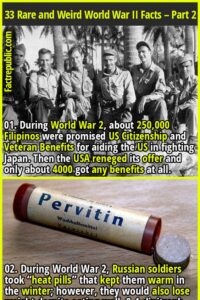World War II, one of the most significant and devastating conflicts in human history, is filled with astonishing facts, both well-known and obscure. In this article, we delve into 33 rare and weird World War II facts that provide a unique perspective on this pivotal period in our global history.

Bicycles Played a Role
During World War II, bicycles became essential for military transportation in many countries, including the Soviet Union and the Netherlands.
The Chocolate Bomber
Gail Halvorsen, an American pilot, became known as the “Candy Bomber” for dropping chocolate bars attached to tiny parachutes to children in West Berlin during the Berlin Airlift.
Pigeon Paratroopers
The British used pigeons equipped with parachutes to carry secret messages during the war.
Bat Bombs
The U.S. developed a “bat bomb” project that aimed to release bats carrying incendiary devices over Japanese cities. The project was never deployed in combat.
Fake Military Installations
The Allies used inflatable tanks and aircraft to create fake military installations, known as “dummy tanks,” to confuse enemy reconnaissance.
The Great Emu War
Australia fought a bizarre “war” against emus in 1932, where soldiers were deployed to control the emu population due to crop destruction.
Invasion by Balloon
Japan launched over 9,000 balloon bombs toward the United States, with a few reaching the West Coast. It was one of the only times the U.S. was bombed during the war.
Nazi Chocolates
The Nazis produced chocolate bars filled with explosives, disguised as popular chocolate brands, in an attempt to assassinate Winston Churchill and other Allied leaders.
Operation Mincemeat
The British carried out “Operation Mincemeat,” using a dead body and fake documents to deceive the Axis powers about the Allied invasion of Southern Europe.
Flying Aircraft Carriers
The United States experimented with flying aircraft carriers, like the USS Akron and the USS Macon, which could launch and recover small airplanes in flight.
The Ghost Army
The 23rd Headquarters Special Troops, known as the “Ghost Army,” used inflatable tanks, sound effects, and other deceptive techniques to confuse the enemy.
War Pigeons for Espionage
Pigeons were not only used for communication but also for espionage. They were equipped with small cameras to capture images behind enemy lines.
The Soviet Anti-tank Dog
The Soviet Union trained dogs to carry explosive charges to enemy tanks. The dogs would be released with the explosives, which would detonate upon contact with the tank.
Invasion of Los Angeles
A false alarm in 1942 led to the “Battle of Los Angeles,” where antiaircraft guns opened fire on supposed enemy aircraft, which later turned out to be weather balloons.
Unexploded Bombs
Even today, unexploded World War II bombs are occasionally discovered, leading to evacuations and bomb disposal operations.
Operation Cherry Blossoms at Night
Japan planned to use submarines to deploy plague as a biological weapon against the United States in Operation Cherry Blossoms at Night, but it was never executed.
Einstein’s Letter
Albert Einstein signed a letter to President Franklin D. Roosevelt, warning of the potential power of nuclear weapons and urging the U.S. to develop its own.
The Hollywood Invasion
Hollywood celebrities like Clark Gable, Jimmy Stewart, and others enlisted and served in various capacities during the war.
The Exploding Anti-tank Hedgehog
The British Royal Navy used “hedgehogs,” anti-submarine weapons that exploded on contact, to protect their ships.
Chicken Guns
The U.S. Navy developed “chicken guns” to test the effects of bird strikes on aircraft, leading to improvements in aircraft design.
The Ghost Blimp
In 1942, a U.S. Navy blimp, known as the “Ghost Blimp,” took off with an unknown pilot and mechanic, and its crew was never found.
The Rubber Soldiers
The U.S. military experimented with creating inflatable soldiers to deceive the enemy, but the project was never used in combat.
The Werewolf Program
Nazi Germany had a plan called “Operation Werewolf” to create guerrilla units to resist Allied occupation, but it had limited success.
V-3 Supergun
Germany developed the V-3, a massive cannon capable of shooting projectiles into space, but it was not used in combat.
Phantom Army Radio
Allied forces created fake radio broadcasts, transmitting false information to deceive the Axis powers.
Churchill’s Pajamas
Winston Churchill had a special pair of silk pajamas with a map of the world to remind him of the global conflict.
The Man Who Never Was
The true story of Glyndwr Michael, a homeless man whose body was used in Operation Mincemeat to mislead the Axis about the invasion of Sicily.
The Doolittle Raid
The famous Doolittle Raid on Tokyo in 1942, led by Lieutenant Colonel Jimmy Doolittle, used B-25 Mitchell bombers launched from an aircraft carrier.
The Mystery of Flight 19
The disappearance of Flight 19, a squadron of five U.S. Navy torpedo bombers, in the Bermuda Triangle in 1945 remains a mystery.
Project X-Ray
The U.S. military developed a plan called “Project X-Ray” to deploy bats carrying incendiary devices, intending to set fire to Japanese cities.
Luftwaffe’s Rocket-Powered Bomber
The Messerschmitt Me 163 Komet was the world’s first rocket-powered fighter aircraft and was used by the Luftwaffe.
Operation Vegetarian
The British tested the feasibility of using shipwrecked animals and debris for human consumption on desert islands in Operation Vegetarian.
The Submarine Aircraft Carrier
The Japanese submarine I-400 carried three aircraft capable of carrying out surprise attacks, marking a unique fusion of submarine and aircraft technology.
Conclusion
World War II was a time of unparalleled innovation, desperation, and intrigue. These 33 rare and weird facts from the era remind us of the astonishing diversity of ideas and tactics employed during this monumental conflict. They also highlight the human capacity for creativity, even in the midst of the darkest moments in history. These stories continue to captivate our imaginations and offer a deeper understanding of the complexities of World War II.
